

Visual Capitalist. Public attitudes towards synthetic biology – Synthetic Biology Future Science Platform. A national survey has been conducted by CSIRO’s Synthetic Biology Future Science Platform as an important first step in measuring public attitudes towards synthetic biology.
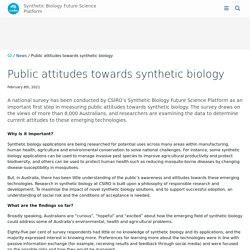
The survey draws on the views of more than 8,000 Australians, and researchers are examining the data to determine current attitudes to these emerging technologies. Why is it important? Synthetic biology applications are being researched for potential uses across many areas within manufacturing, human health, agriculture and environmental conservation to solve national challenges. For instance, some synthetic biology applications can be used to manage invasive pest species to improve agricultural productivity and protect biodiversity, and others can be used to protect human health such as reducing mosquito-borne diseases by changing disease-susceptibility in mosquitoes.
But, in Australia, there has been little understanding of the public’s awareness and attitudes towards these emerging technologies. In summary… Washington State Department of Agriculture. NY Research Priorities - New York Invasive Species Research Institute. Sandbox. US Forest Service Research & Development. LocalgovtAIS. LocalgovtAIS. Guide for authors - Ecological Informatics - ISSN 1574-9541. Download Guide for Authors in PDF The journal Ecological Informatics is devoted to the publication of high quality, peer-reviewed articles on all aspects of computational ecology, data science and biogeography.

Protect Montana Waters from Aquatic Invasive Species. White-Nose Syndrome. SECURE Rule Regulatory Changes. REGULATORY STATUS REVIEW PROCESS Will be implemented for certain crops on April 5, 2021 and fully implemented on October 1, 2021 Under the previous regulations, APHIS assessed the plant pest risk of each plant transformation event (also sometimes referred to as the individual transformed line, transgenic line, or genetically-engineered (GE) line) separately, even though the inserted genetic material may have been identical or very similar to transformation events already assessed.
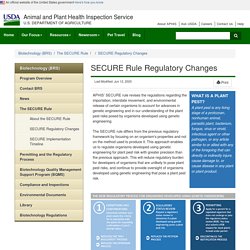
This has sometimes been referred to as an “event-by-event” approach. EDDMapS. Invasive Range Expanders Listing Tool Terrestrial invasive plants are expected to shift their ranges in response to changing climate.
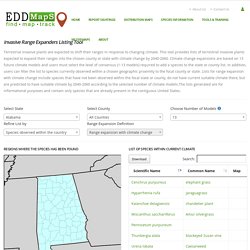
This tool provides lists of terrestrial invasive plants expected to expand their ranges into the chosen county or state with climate change by 2040-2060. Climate change expansions are based on 13 future climate models and users must select the level of consensus (1-13 models) required to add a species to the state or county list. In addition, users can filter the list to species currently observed within a chosen geographic proximity to the focal county or state.
Alabama All Counties Species observed within the country. Resource Center – Wildlife Forever. Hi-Knowledge. Home - MIREN. Early Detection and Rapid Response. While invasive species prevention is the first line of defense, even the best prevention efforts will not stop all invasive species.

Early Detection and Rapid Response (EDRR) is defined as a coordinated set of actions to find and eradicate potential invasive species in a specific location before they spread and cause harm. USGS activities that support EDRR span the geography of the country and address organisms and pathways most appropriate to address the needs of our partners. USGS provides scientific support to DOI Bureaus and other partners to aid in implementation of EDRR efforts and inform management actions. In certain cases, USGS leads multi-agency / partner rapid response efforts where specific skill sets are required.
Browse Early Detection and Rapid Response science related to: Date published: August 6, 2019. Environmental Risk Assessment of the Products of Biotechnology. Modern biotechnology has extended humans' manipulation and modification of biological resources for a range of purposes.
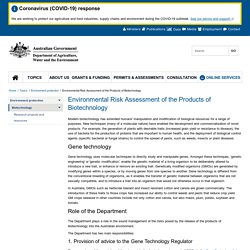
New techniques (many of a molecular nature) have enabled the development and commercialisation of novel products. For example, the generation of plants with desirable traits (increased grain yield or resistance to disease), the use of bacteria for the production of proteins that are important to human health, and the deployment of biological control agents (specific bacterial or fungal strains) to control the spread of pests, such as weeds, insects or plant diseases. Gene technology Gene technology uses molecular techniques to directly study and manipulate genes. Amongst these techniques, 'genetic engineering' or 'genetic modification', enable the genetic material of a living organism to be deliberately altered to introduce a new trait, or enhance or remove an existing trait. Role of the Department. ArcGIS Web Application. Northeast RISCC Management. National Plant Board – Laws and Regulations.
Global Gene Editing Regulation Tracker and Index. Home - Regional IPM Centers. USGS Biosurveillance Network. World Customs Organization. Rapid Response Kit – Wildlife Forever. ZAHP – All Hazards Preparedness. Collaborative Forest Landscape Restoration Program. CFLRP Reauthorized The 2018 Farm Bill, which became law on December 20, 2018, includes a reauthorization of the Collaborative Forest Landscape Restoration Program (CFLRP) through fiscal year 2023.

See the Farm Bill language about CFLRP (amendments to the original 2009 CFLRP legislation on pg. 376). Depending on appropriations, the 13 CFLRP projects selected in 2012 will be prioritized for funding their final two years of planned implementation. We will be recruiting strong candidates, through the CFLRP Federal Advisory Committee Act (FACA), to consult with the Secretary on decisions regarding new project selection and case-by-case extensions for existing 10-year projects.
Per the legislation, the FACA Advisory Panel nominations will include experts in: Overview. Congress established the Collaborative Forest Landscape Restoration Program (CFLRP) with Title IV of the Omnibus Public Land Management Act of 2009 (PDF, 40 KB).
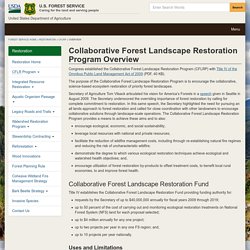
The purpose of the Collaborative Forest Landscape Restoration Program is to encourage the collaborative, science-based ecosystem restoration of priority forest landscapes. Secretary of Agriculture Tom Vilsack articulated his vision for America’s Forests in a speech given in Seattle in August 2009. The Secretary underscored the overriding importance of forest restoration by calling for complete commitment to restoration. In this same speech, the Secretary highlighted the need for pursuing an all lands approach to forest restoration and called for close coordination with other landowners to encourage collaborative solutions through landscape-scale operations. The Collaborative Forest Landscape Restoration Program provides a means to achieve these aims and to also:
Prefab Modern Sheds and Backyard Studios. Threatened Island Biodiversity Database. Global Islands Explorer Home. About Habitattitude™ - Habitattitude™ Protect our environment. Habits, Attitude, and Habitat—together they comprise HabitattitudeTM.
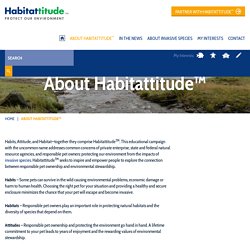
This educational campaign with the uncommon name addresses common concerns of private enterprise, state and federal natural resource agencies, and responsible pet owners: protecting our environment from the impacts of invasive species. HabitattitudeTM seeks to inspire and empower people to explore the connection between responsible pet ownership and environmental stewardship. Habits – Some pets can survive in the wild causing environmental problems, economic damage or harm to human health. Choosing the right pet for your situation and providing a healthy and secure enclosure minimizes the chance that your pet will escape and become invasive.
Habitats – Responsible pet owners play an important role in protecting natural habitats and the diversity of species that depend on them. Attitudes – Responsible pet ownership and protecting the environment go hand in hand. Space Enabled. The mission of the Space Enabled research group is to advance justice in Earth's complex systems using designs enabled by space.
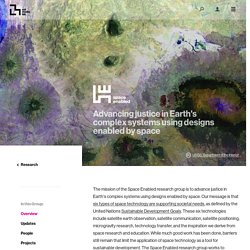
Our message is that six types of space technology are supporting societal needs, as defined by the United Nations Sustainable Development Goals. These six technologies include satellite earth observation, satellite communication, satellite positioning, microgravity research, technology transfer, and the inspiration we derive from space research and education. While much good work has been done, barriers still remain that limit the application of space technology as a tool for sustainable development. The Space Enabled research group works to increase the opportunities to apply space technology in support of the Sustainable Development Goals. Our research applies six methods, including design thinking, art, social science, complex systems, satellite engineering and data science. Westernais. Wisconsin Invasive Species Calendar – Wisconsin First Detector Network.
GB non-native species secretariat. GloFouling Project. The GloFouling Partnerships is a project to address the transfer of harmful aquatic species through biofouling in some of the developing regions of the world. Global forecasts of shipping traffic and biological invasions to 2050. CIRCABC - Welcome. National Environmental Biosecurity Response Agreement Review. The National Environmental Biosecurity Response Agreement (NEBRA) was signed by the Commonwealth, state and territory governments in January 2012. It establishes the national arrangements for responding to significant pest and disease incursions where there are predominantly public benefits. In 2017 an independent review was undertaken of the implementation and effectiveness of the NEBRA agreement in the five years since its commencement has been completed.
ABARES Invasive species. Page Content Invasive species, such as vertebrate pests, weeds, marine pests and diseases, are a key threat to Australia’s agriculture, fisheries and forestry industries and the environment. Committee Members - National Site for the Regional IPM Centers. A national umbrella site for the regional IPM centers Members of the Federal IPM Coordinating Committee Department of Agriculture Agricultural Research Service/OPMP David Epstein (david.epstein@ars.usda.gov) Lookup Tool: Invasive Species Management Areas. Pests and Diseases. Biodefense Policy Landscape Analysis Tool. IPM Road Map FINAL. AIDO. WAFWA - Western Association of Fish and Wildlife Agencies. Marine Invasive Species Monitoring in New England. Explore data from the Marine Invader Monitoring and Information Collaborative (MIMIC) through this story map. What are invasive species? Invasive species are animals, plants, and other organisms (such as viruses) that are introduced to a new location by human activity and can cause harm to the environment, economy, or public health.
More than 60 invasive species have been documented in the coastal waters of New England, though this is likely an underestimate. Conservation Evidence - Site. Home - Great Lakes Hydrilla Collaborative. Minister Hanekom announces release of Status Report on Biological Invasions in South Africa - SANBI. The Acting Minister of Environmental Affairs, Mr Derek Hanekom, has announced the release of the National Status Report on Biological Invasions in South Africa. FIFRA Scientific Advisory Panel. Home - National Site for the Regional IPM Centers. Seeking community guidance for a project aiming to humanely remove invasive rodents. Willie Crear,boatbuilder - Home. eDNA Clearing House. Debug Project. Maps. Guitar League - Home. Exotic Pet Veterinary Care - Stahl Exotic Animal Veterinary Services. Newpiertaxa. Home. Mule Resonator Guitars - Handmade Steel Custom Resonator Guitars.
Ant wars. Tree-SMART Trade. Boat Speed/Tuning/Sailtrim Articles Archives - Sail1Design. Tactics & Strategy Archives - Sail1Design. Digital Coast Home. COST Action FP1401 – Global Warning - Instytut Badawczy Leśnictwa. Nutria Story Map. National Environmental Policy Act. Rozalia Project. CitSci.org - Comprehensive citizen science support. Welcome to SciStarter. VectorBase. Creating the Ecosystem — Conservation X Labs. Building the Ecosystem. Protecting Land and Waterways. Invasive & Non-Native Species. Canadian Council on Invasive Species. Plans and Documents — California Islands. AFPMB - Living Hazards Database. Biodiversité des Petites Antilles: Exotiques. Home » Marine Biosecurity Porthole. Genetic Engineering and Society Center. Northeast Aquatic Nuisance Species Panel Forum » Published papers relative to aquatic invasive species.
Alaska Center for Conservation Science. Major funding from: North Pacific Research Board A partnership between UAA’s Alaska Center for Conservation Science, the Aleutian and Bering Sea Islands LCC, Alaska Sea Grant, and U.S. WIONIS : the Network - Resources and information on agriculture and biodiversity in the Indian Ocean. IUCN/SSC Invasive Species Specialist Group (ISSG) Plant science scan: A103-3E-PDF - Government of Canada Publications. MarineTraffic: Global Ship Tracking Intelligence. Interactive: Mapping the Flow of International Trade.
Map: Visualizing Every Ship at Sea in Real-Time. The ocean is a big place, which makes it a pretty difficult thing to wrap our brains around. Mapped: Global Shipping Routes, Using 250 Million Data Points. How busy are the world’s shipping routes, and where are the global chokepoints for commercial shipping? Today’s visualization compiles 250 million data points, representing the movement of the world’s commercial shipping fleet based on hourly data from 2012. The interactive map below breaks up the merchant fleet into five ship types: container ships, dry bulk carriers, oil and fuel ships, gas ships, and carriers transporting vehicles. The interactive map was created by data visualization outfit Kiln, along with the UCL Energy Institute. Pocket: Log In. Sail La Vie. Twofold Textiles & Travel. Invasive alien species and climate change. Saildrone.